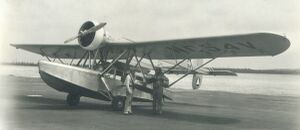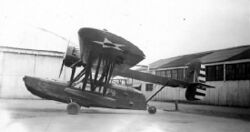Engineering:Sikorsky S-39
| S-39 | |
|---|---|

| |
| Sikorsky S-39 of the Civil Air Patrol, 1942 | |
| Role | Flying boat |
| National origin | United States |
| Manufacturer | Sikorsky Aircraft |
| First flight | 24 December 1929 |
| Number built | 21 |
The Sikorsky S-39 is an American light amphibious aircraft produced by Sikorsky Aircraft during the early 1930s. The S-39 was a smaller, single-engine version of the S-38.[1]
Operational history
Spirit of Africa
Filmmakers Martin and Osa Johnson used a giraffe-patterned S-39 Spirit of Africa, with companion zebra-striped S-38 Osa's Ark, to explore Africa extensively, making safari movies and books.[2]
Military usage

One example of the S-39 was acquired by the United States Army Air Corps in 1932, given the designation Y1C-28. It was evaluated for use in coastal patrol and light transport roles; in 1934 it was redesignated C-28 and assigned as a liaison aircraft to the United States Military Academy.[3]
At least one S-39 saw service with the Civil Air Patrol Coastal Patrol from 1942 to 1943. This was part of a fleet of civilian aircraft flown by volunteers along the Atlantic and Gulf Coasts, searching for both German submarines and for allied ships in distress. Seaplanes such as the S-39 were sometimes used for search and rescue if another aircraft crashed or went missing.[4] A surviving CAP S-39, previously based at Rehoboth Beach, Delaware, is currently on display at the New England Air Museum.
Yacht
Edward A. Deeds had the yacht Lotosland designed to incorporate aircraft capability. After loss of the planned aircraft on first loading Deeds ordered an S-39-A replacement the next day. The aircraft was intended to allow Deeds to quickly travel from his yacht to business and events ashore.[5][6][7]
Variants
- S-39-A
- 4-seat version[8]
- S-39-B
- Improved 5-seat version of the S-39-A[8]
- S-39-C
- Converted from S-39-B[9]
- C-28
- One example of the S-39 acquired by the United States Army Air Corps
Surviving aircraft

- 904 – S-39-B on static display at the New England Air Museum in Windsor Locks, Connecticut.[1]
- Composite – S-39-C airworthy with at Fantasy of Flight in Polk City, Florida.[10][11] It was recovered from Alaska in 1965 and incorporated parts of five S-39s. It was restored by Dick Jackson and first flew in 2003.[9][12]
- 920 – S-39-C under restoration with Frederick W. Patterson III of American Canyon, California. This is the last S-39 produced and was originally owned by Shell Eastern, the original name of the Shell Oil Company.[13][failed verification]
Specifications (S-39A)
Data from Aerofiles : Sikorsky,[14] American flying boats and amphibious aircraft : an illustrated history[15]
General characteristics
- Crew: 1 or 2
- Capacity: 4 or 5 pax / 1,145–1,300 lb (519–590 kg) payload
- Length: 31 ft 11 in (9.73 m)
- Wingspan: 52 ft 0 in (15.85 m)
- Wing area: 320 sq ft (30 m2)
- Airfoil: Sikorsky GS-1 [16]
- Empty weight: 2,678 lb (1,215 kg)
- Gross weight: 4,000 lb (1,814 kg)
- Powerplant: 1 × Pratt & Whitney R-985 Wasp Junior 9-cylinder air-cooled radial piston engine, 300 hp (220 kW)
Performance
- Maximum speed: 115 mph (185 km/h, 100 kn)
- Cruise speed: 97 mph (156 km/h, 84 kn)
- Stall speed: 54 mph (87 km/h, 47 kn)
- Range: 375 mi (604 km, 326 nmi)
References
- ↑ 1.0 1.1 "Sikorsky S-39B "Jungle Gym"". https://neam.org/shell.php?page=aircraft_collection_detail&name=sikorskys39b.
- ↑ "Flying Expedition To Africa To Visit Forbidden Area." Popular Mechanics, April 1933.
- ↑ "Sikorsky Y1C-28." National Museum of the United States Air Force, June 24, 2009. Retrieved: July 15, 2017.
- ↑ Blazich, Frank A. Jr. (2020). An honorable place in American air power": Civil Air Patrol coastal patrol operations, 1942-1943. Air University Press. p. 109-112. ISBN 978-1-58566-305-7. https://www.airuniversity.af.edu/Portals/10/AUPress/Books/B_0168_BLAZICH_AN_HONORABLE_PLACE_IN_AMERICAN_AIR_POWER_CIVIL_AIR_PATROL_COSTAL_PATROL_OPERATIONS_1942_1943.PDF. Retrieved September 21, 2021.
- ↑ "The Diesel Yacht Lotosland". MotorBoating: 90–91. February 1931. https://books.google.com/books?id=PfJgN6a-pGsC&pg=PA90. Retrieved 23 October 2020.
- ↑ Pacific American Steamship Association; Shipowners Association of the Pacific Coast (August 1929). "Diesel Yacht Lotosland". Pacific Marine Review (San Francisco: J.S. Hines): 29. https://archive.org/stream/pacificmarinerev2629paci#page/n545/mode/1up. Retrieved 23 October 2020.
- ↑ "S38". NEAM News (Windsor Locks, Ct.: New England Air Museum): 4. Fall 1994. https://www.neam.org/images/docent-portal/history/sikorsky_s-39.pdf. Retrieved 23 October 2020.
- ↑ 8.0 8.1 "A.T.C. #375". http://www.goldenwingsmuseum.com/collection/Aircraft%20Info%20Sheets/Sikorsky%20S-39-C.pdf.
- ↑ 9.0 9.1 Jackson, Dick. "40 Years and 40,000 Hours". Richard Jackson. http://www.spiritofigor.com/history.html.
- ↑ "1930 Sikorsky S-39". 17 September 2013. http://www.fantasyofflight.com/collection/aircraft/currently-not-showing-in-museum/golden-age/1930-sikorsky-s-39.
- ↑ "FAA REGISTRY [N50V"]. U.S. Department of Transportation. http://registry.faa.gov/aircraftinquiry/NNum_Results.aspx?NNumbertxt=50V.
- ↑ Jackson, Dick. "40 Years and 40,000 Hours - Part 2". Richard Jackson. http://www.spiritofigor.com/history2.html.
- ↑ "FAA REGISTRY [N58V"]. U.S. Department of Transportation. http://registry.faa.gov/aircraftinquiry/NNum_Results.aspx?NNumbertxt=58V.
- ↑ Eckland, K.O.. "american airplanes: Sikorsky". http://aerofiles.com/_sik.html.
- ↑ Johnson, E.R. (2009). American flying boats and amphibious aircraft: an illustrated history. Jefferson, N.C.: McFarland & Co.. pp. 188–189. ISBN 978-0-7864-3974-4.
- ↑ Lednicer, David. "The Incomplete Guide to Airfoil Usage". https://m-selig.ae.illinois.edu/ads/aircraft.html.
External links
 |

